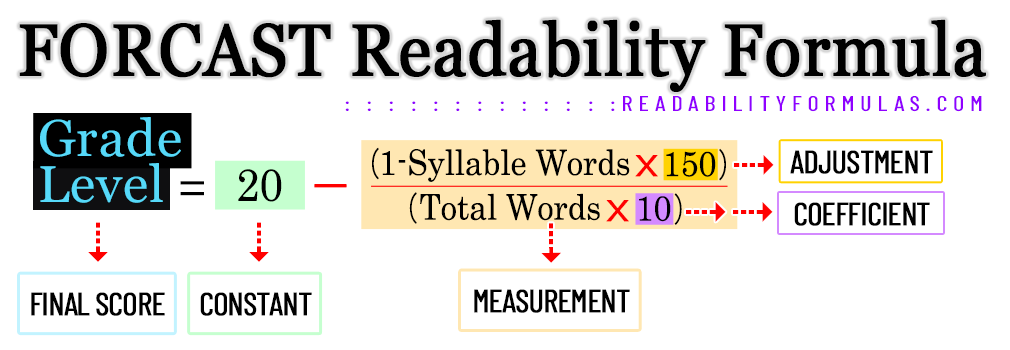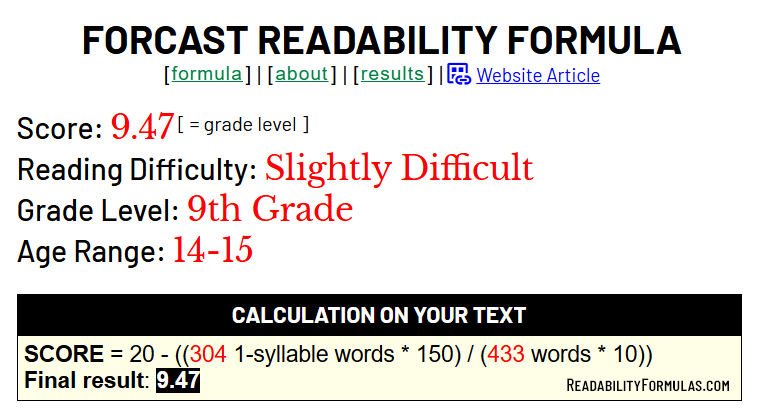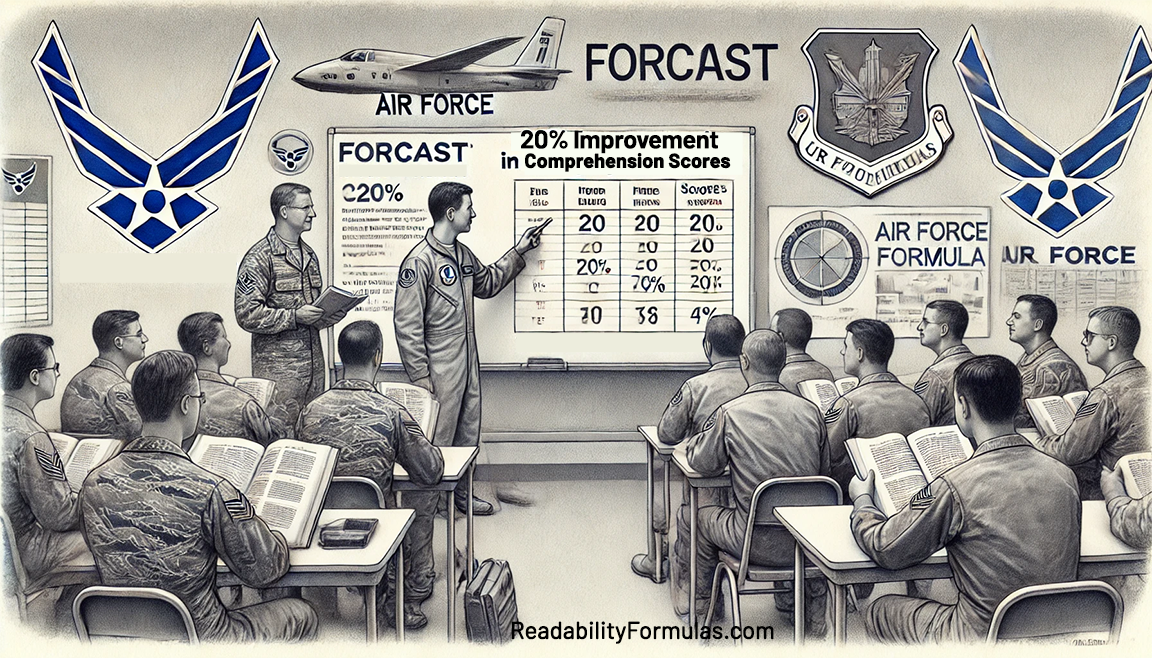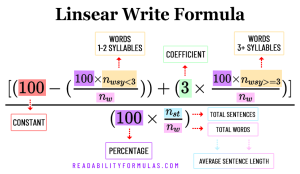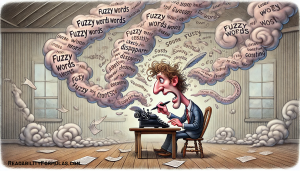FORCAST Readability Formula is the only formula not designed for running narrative or connected text. It counts syllables instead of familiar words and ignores sentence length. This focus makes it best for texts that don’t have full sentence stops or the usual paragraph format. Therefore, you can apply it on multiple-choice quizzes, applications, instructional texts, entrance forms, technical manuals, and so on. FORCAST can score texts above primary age reading materials, from 5th grade to college. (You can score your text using our free FORCAST Readability Calculator.)
The making of FORCAST is historically noteworthy. In the early 1970s, as the draft called thousands to serve during the Vietnam War, the U.S. Army faced a literacy challenge: many fresh-faced recruits struggled with basic reading. Military manuals and directives might as well have been written in code. It was an issue that, if ignored, threatened to weaken the very fabric of the military’s operations.
The Human Resources Research Organization (website) assigned linguists J. Patrick Ford, John S. Caylor, and Thomas G. Sticht to study the reading guidelines of military occupational specialties (MOS). Their subjects were Vietnam draftees entering basic training and job-specific military roles. The FORCAST (FORd, CAylor, STicht) formula evolved from their research. The formula, first announced in 1973, could assess how complex reading materials were for different military roles. This helped HR place recruits in roles that fit their reading skills.
A few years later, in one of his famous “fireside chats,” President Carter pushed for clearer government documents, especially in the military where understanding the written word is vital. If people can’t understand regulations and directives, this confusion can waste resources and harm safety and morale. Reacting to President Carter’s call, the Air Force decided to reduce their publications and simplify the remaining ones.
They set out to:
- See who needed to read each publication.
- Measure the reading level of these readers.
- Compare this level with each publication’s complexity.
- Ask technical writers to close the gap between what readers could understand and what the publications said.
Because of its ease of use and accuracy (especially on technical materials), the Air Force approved using the FORCAST formula on all of its publications.
The FORCAST Readability Formula
where
Step 1: Select a sample text 150 words or more.
Step 2: Count NWS (the number of single-syllable words) and multiply by 150.
Step 3: Multiply the total number of words by 10.
Step 4: Divide total # of single-syllable words by total # of words.
Step 5: Subtract the result in Step 4 from 20.
The result is a U.S. Grade Level.
Understanding the Numbers in FORCAST
Each number in this formula serves a purpose in normalizing the readability score.
The Constant 20 (Baseline Starting Score)
- The number 20 acts as a reference point for the readability score.
- The FORCAST formula is unique because it doesn’t use sentence length—it only considers word syllables.
- In the original research by Caylor and Sticht (1973), they decided 20 was the upper tier for readability scores before adjusting for word difficulty.
- If all words were multi-syllable, the score would stay close to 20.
- As more 1-syllable words appear, the score decreases, making the text easier to read.
The 150 Adjustment
- This number scales the 1-syllable word count proportionally.
- FORCAST was tested on 150-word samples.
- If a text is longer or shorter than 150 words, this number normalizes the effect so we can compare the score across texts of different lengths.
Why multiply by 150?
- If you analyze a text with 300 words, you’d expect about twice the number of 1-syllable words compared to a 150-word sample.
- The 150 multiplier adjusts for this difference by ensuring that we’re projecting the 1-syllable count onto a standard 150-word sample size.
- Without this scaling factor, the formula would be invalid across different text lengths.
The 10 in the Denominator (Coefficient)
- This divides the effect of the 1-syllable words, ensuring the final score stays within a reasonable range.
- The higher the total word count, the smaller the impact of each additional 1-syllable word.
- The 10 divisor ensures the score is not overly sensitive to minor changes in word usage.
Why divide by 10?
- Dividing by 10 aligns scores with U.S. grade levels.
- If we didn’t divide by 10, the subtraction effect would be too large, and scores would drop too quickly.
- This ensures a gradual and realistic decrease in readability scores based on how many 1-syllable words are in the text.
| Text Type | Common FORCAST Scores | Interpretation |
|---|---|---|
| Technical Manuals | 15.5 | Very difficult, requires specialized knowledge |
| Scientific Papers | 14.2 | Requires higher education (college-level) |
| News Articles | 12.8 | Moderately difficult, aimed at general adults |
| Children’s Books | 6.5 | Very easy, accessible to elementary readers |
| Academic Essays | 13.7 | Requires high school or early college education |
| Government Reports | 14.9 | Complex, formal bureaucratic language |
| Fiction Novels | 9.0 | Aligned with 8th-grade readability level |
| Instructional Guides | 8.3 | Slightly easier than fiction, straightforward style |
FORCAST remains relevant and helpful in today’s diverse and fast-paced world:
- The Air Force improved comprehension scores among trainees by 20% when technical manuals were assessed and revised using the FORCAST formula compared to other readability formulas.
- A report by the National Center for Education Statistics (NCES) highlighted that students using materials revised for readability, including those assessed by FORCAST, improved standardized test scores by 15%.
- The International Literacy Association noted readability assessments like FORCAST can help develop educational tools that cater to diverse learning needs, especially in STEM education.
- A study by the Society for Technical Communication found that adjusting text readability can reduce comprehension errors in technical manuals by 35%.
- A study by the U.S. Department of Education found that using readability formulas can help readers comprehend technical texts by up to 25%.
FORCAST complements other formulas by filling a gap for a specific type of text; other formulas like Flesch-Kincaid or Dale-Chall do not score as accurately on non-narrative texts.
Scott, Brian. “The FORCAST Readability Formula for Technical & Advanced Texts.” ReadabilityFormulas.com, 14 Feb. 2025, https://readabilityformulas.com/forcast-readability-formula-php/.
